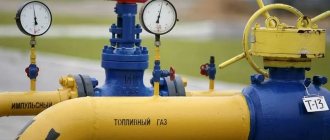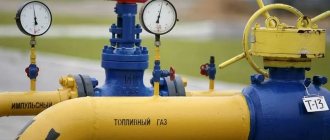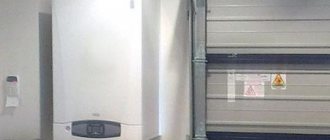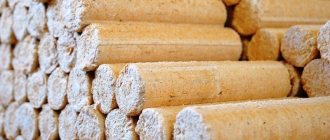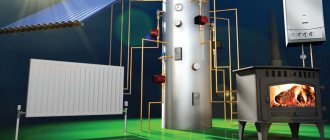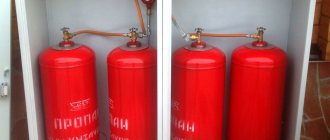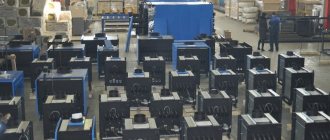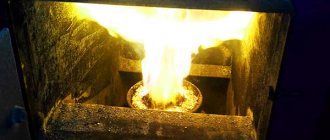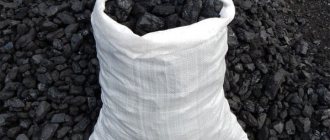How many cubic meters of firewood do you need for the winter?
To find out how much firewood is needed for the winter, you need to consider several factors. In addition to the percentage of moisture and type of wood, you should definitely look at the type of logs (round, split, a mixture of two types). A significant factor is the length of time during which the home will be heated. In many Russian regions, it takes a long time to heat houses - for 6–7 months. All this affects how many cubic meters of spruce and oak will be required to maintain a comfortable atmosphere in the rooms. The longer the boiler system operates, the more combustion material will be used.
When to prepare firewood?
The best time to prepare firewood is the end of autumn and the beginning of winter. Work should be carried out in dry weather. During this period, sap flow stops and the moisture content of the wood decreases. Chocks are much easier to split into firewood. In addition, it is easier to cut down trees without leaves.
The trunks are sawed into logs, which are then split into firewood. They are placed in a ventilated shed until next autumn. They will dry out within a year.
© Ilya Vladimirovich | 2017-10-16 He's also a gardener
What you need to know to calculate
How much firewood is needed to heat a house depends on several factors:
- the amount of thermal power spent on heating;
- equipment in use;
- types of wood;
- wood humidity.
According to the standards, the thermal power is 1 kW of heat per 10 sq. m in extreme cold. The average value is 0.5 kW. Thus, for a building of 100 sq. m it will be 5 kW.
The more spacious the housing, the higher the fuel consumption. The efficiency of different types of heating devices differs. For most solid fuel boilers this parameter reaches 70–75%. Pyrolysis models are more efficient - their efficiency reaches 80%. Russian and steel stoves have the lowest heat output. Their efficiency on average is 65%, 55%, respectively.
Deciduous and coniferous trees are used for heating. Birch has the highest heat transfer – 2371 kW/cu.m. m at 50% moisture content and 2716 kW/cu.m. m at 20% water content. The minimum calorific value of a Christmas tree is 1667 kW/m3 at a humidity of 50% and 1902 kW/m3 at a moisture content of 20%.
| Wood type | Calorific value of freshly cut wood at 50% humidity, kW/m3 | Calorific value of semi-dry wood 30% humidity | Calorific value of dry wood 20% humidity, kW/m3 |
| Pine | 1900 | 2071 | 2166 |
| Birch | 2371 | 2579 | 2716 |
| Spruce | 1667 | 1817 | 1902 |
| Aspen | 1835 | 1995 | 2117 |
| Alder | 1972 | 2148 | 2244 |
| Ash | 2550 | 2774 | 2907 |
Table 1. The calorific value of firewood of different types, related to the measure of volume - 1 m³.
When preparing for wintering, you need to know how to calculate cubes of firewood. For this purpose, special formulas have been developed to calculate the norm of logs for the autumn-winter season.
Rules and safety precautions when collecting firewood
When working with an ax, check the reliability of the handle and, if necessary, make repairs. The electric wood splitter is inspected for cable integrity. The machine is freed from foreign objects and, following the following rules, safety precautions are observed:
- Wear overalls, gloves and goggles. Shoes are selected with stable soles.
- The cord is connected to the network. Autonomous equipment is filled with gasoline and lubricating oil.
- The log is placed on the work surface in a horizontal position. The cleaver is passed along the fibers.
- If a hard knot is encountered, set the pusher handle to the “Start” position and repeat the blow.
Warning! The employee must not be in a state of alcohol, drugs or under the influence of potent medications.
How is fuel calculated for the season?
How to calculate firewood for heating a house:
V = 720 * Q / (q * 0.01 efficiency), where
720 – number of hours per month (24 hours * 30 days);
V – amount of biofuel for one month;
Q – heat required to heat the building (kilowatt-hour);
q is the calorific value of 1 cubic meter of wood depending on the degree of drying (kW/m3);
Efficiency – efficiency of the heating device (%).
| Length, m | Full wood coefficient for logs | |||||||
| Conifers | Hardwood | |||||||
| Round | Broken | A mixture of round and chopped | Round | Broken | A mixture of round and chopped | |||
| thin | average | thin | average | |||||
| 0,25 0,33 0,50 0,75 1,00 1,25 1,50 2,00 2,50 3,00 | 0,79 0,77 0,74 0,71 0,69 0,67 0,66 0,64 0,62 0,61 | 0,81 0,79 0,76 0,74 0,72 0,71 0,703 0,68 0,67 0,65 | 0,77 0,75 0,73 0,71 0,70 0,69 0,68 0,66 0,64 0,63 | 0,77 0,75 0,73 0,72 0,70 0,69 0,68 0,67 0,66 0,65 | 0,75 0,72 0,69 0,65 0,63 0,61 0,60 0,58 0,56 0,55 | 0,80 0,78 0,75 0,72 0,70 0,68 0,67 0,65 0,63 0,62 | 0,76 0,74 0,71 0,69 0,68 0,67 0,65 0,63 0,62 0,60 | 0,76 0,74 0,71 0,69 0,68 0,67 0,66 0,65 0,64 0,63 |
Table 2. Full wood coefficient for logs
The result will be a value that will show the optimal volume of birch, spruce, ash to provide the living space with heat. But these are not ready-made logs that are put into the oven. To find out how much firewood is needed to heat a house, you need to divide the found value by the conversion factor. Each type of tree has its own. In addition, the shape, footage and thickness of the log are taken into account. For example, if it is round, of medium thickness, coniferous, then with a length of 50 cm the conversion factor is 0.72.
To obtain the amount of solid fuel for the full season autumn - spring, you will need to multiply the resulting value by the number of months of the year in which the building will be heated.
Basic ways to save heat
Economical heating of a private house with wood has become possible thanks to the use of modern stoves: fireplaces with closed fireboxes have doubled the efficiency, and it reaches 75%, just like good gas stoves. Even if you decide to install a regular Russian stove, its efficiency can also vary significantly.
This depends on the materials, the correctness of the masonry, and the performance of the chimney. A wood heating stove with an efficiency of 90% remains an unattainable dream for many: so far only high-tech gas equipment can boast such efficiency.
When heating a house with wood, consumption can be reduced using simple “rustic” methods that have been used for decades. A few basic measures will make it possible to significantly reduce heating costs:
- The optimal amount of heat is provided only by dry firewood, the combustion of which produces clear smoke with a pleasant woody smell. When burning wet wood, white steam appears - the evaporation of water leads to wasted heat loss and ineffective combustion of fuel.
- The efficiency of the stove is significantly reduced if the chimney is clogged with ash and soot. At the same time, traction deteriorates, and due to an insufficient supply of oxygen, the fuel does not burn completely, giving off a minimum of heat.
- There is another method, which, according to home owners, makes it possible to reduce fuel consumption by half. It involves taking combustion air not from the room, but from the street: the increased flow of oxygen allows the wood to burn out entirely, while it will not take heat from the house.
- The most important condition for saving fuel is proper insulation of the house. It is necessary to insulate not only the walls, but also the floor, foundation, and roof.
It is not difficult to distinguish dry wood: if you hit one log on another, the sound should be clear. It is important to ensure that firewood is stored correctly so that it will always be ready for use.
In addition, toxic carbon monoxide can be released, which can negatively affect human health. Regular cleaning of furnaces can completely solve the problem: removing soot from the walls increases the performance of the entire system.
Thus, modern gas boilers are initially designed to take air from the street. When modifying the design, the stove can take air from the basement of the house.
Most of the heat simply leaves the house through unsealed cracks in the walls or cold bridges in the under-roof space. For your home, you can use modern insulation in combination with waterproofing and vapor barrier membranes.
An economical wood-burning stove for heating a house involves the use of a water or air circuit for heating. In this case, the heat will be evenly distributed throughout the rooms, and for this it is not necessary to use a large amount of fuel.
Such heating is possible by installing an additional heat exchanger in the furnace structure: the most common solution is the so-called “water jacket”. The water is heated by the combustion of fuel and enters the piping system to the radiators, after which it returns to the furnace.
This heating system eliminates the main drawback of a traditional wood stove: uneven heating of the air in the rooms. If it is always very warm near the stove, then in distant rooms the air will always be much colder. If you install radiators and turn an ordinary stove into a solid fuel boiler, this will allow you to warm up every room.
Calculation of firewood consumption for heating a house of 100 m2
How much firewood is needed to heat 100 m2 can be easily calculated using the previously stated formula. In the example, we will consider the option of using 50 cm chopped pine logs that have been pre-dried. They will be burned in a pyrolysis boiler, which has an efficiency of 80%. Heat consumption for heating (Q) during the frosty season is approximately five kilowatts per hour.
The calorific value (q) for dried pine is 2166 kW per cubic meter. It must be substituted into the formula. Result:
V = 720 * 5 / (2166 * 0.01 * 80) = 2.08.
The second stage is to determine the rate of split pine, calculated in folding meters. It is equal to 0.73. We perform arithmetic operations:
2.08 / 0.73 = 2.85 cubic meters m.
Let’s assume that the building is planned to be heated for five months. The calculated value must be multiplied by them. It turns out that you will need 2.85 * 5 = 14.25 m3 of dried pine.
To understand how much wood is needed to heat structures of 150 m2, 200 m2, the final figures are increased by one and a half to two times.
Important characteristics of logs, depending on the type of wood
When asking the question “which firewood is best for a solid fuel boiler,” you need to know its most significant characteristics. In particular:
- calorific value;
- ash content
A long-burning solid fuel heating boiler that uses wood with high ash content will have to be cleaned frequently. Without taking this into account, the grates of the boiler unit will quickly become clogged with ash, which will lead to a decrease in the efficiency of the boiler. Of course, if the basis for private heating is a long-burning solid fuel boiler on wood with a fully automated mode, then there is nothing to worry about. Otherwise, you need to change the type of wood.
Another important characteristic of firewood is its calorific value. Using wood logs with a high calorie content, a long-burning solid fuel heating boiler will withstand the required heat load for a long time, creating the desired temperature regime in the interior space of a country cottage. This characteristic largely depends on the density of the wood itself.
As a result of experimental tests, the following results were obtained for the most common types of firewood (list in descending order):
- oak – 3106 kcal;
- birch – 2805 kcal;
- pine – 2128 kcal;
- from alder – 2095 kcal;
- spruce – 1847 kcal;
- aspen - 1764 kcal.
Despite the fact that oak firewood is the most efficient in producing heat, its cost is significantly higher than all other types of firewood. Thus, it is more profitable to heat a solid fuel heating boiler, based on the cost of wood fuel, with birch firewood.
Wood briquettes
This type of briquettes is made from sawdust and other materials - waste from the wood processing industry. The raw materials are first heated and then pressed. To do this, use high pressure on the chips. Under pressure from the load, the wood releases lignin. It acts as glue. After it hardens, the mass does not lose its shape and is quite durable to the touch. Lignin is a natural material and does not cause any harm to the human body. Wood briquettes have some important characteristics. Fuel moisture content is 10%. As you can see, the moisture content of the finished material is several times lower than wood. At the moment of combustion, sawdust releases 4400 kcal/kg. If we compare this indicator and heating with sawdust with burning coal, we note that the indicator is 3910 kcal/kg.
Wood briquettes
If you compare it with coal, when burned, wood produces several times less carbon monoxide than other materials. The form in which wood blocks are produced is convenient in practice. This allows you to not take up a lot of space for fuel storage. Euro firewood is suitable as fuel not only for solid fuel boilers. They can be used to start a fire outdoors and to light a fireplace. Also, firewood in the form of wood blocks is easy to control consumption.
From autumn to spring.
According to the norm for heating from autumn to spring, every 10 square meters. m of living space, with normal thermal insulation, about 1 cubic meter of firewood is required, taking into account the fact that the firewood is not wet aspen, which, as is known, does not burn without kerosene. As for the bathhouse, it all depends on how committed you are to steam, broom and other soapy procedures: after all, the bathhouse can be heated once, twice, or three times a week. But if we stop at two furnaces, then I undertake to say that with 5 cubic meters a bathhouse can be heated for a whole year.
Bulk instead of real ones.
Let me draw your attention once again to the fact that we are talking about dry firewood with a moisture content of no more than 20%. The calorific value of 1 kg of such firewood will be at least 4 kW. But if their humidity turns out to be increased, which most often happens, then their calorific value drops sharply. For example, 50% humidity will reduce the heating value of firewood by half. So the main disadvantage of wet firewood is not that it does not burn well, but that it produces little heat. And finally, about one more trick that firewood sellers most often resort to. Cubic meters are real, folded and bulk. You pay money for a real cubic meter, but, alas, a rare seller uses real cubic meters when calculating the volume. In the best case, you will get folded cubic meters, in the worst - bulk. So not only trust, but also verify!
The cheaper way to heat your home
The price of fuel for heating a private home is of great importance, but it is pointless to consider it in isolation from heat transfer. We will calculate the cost of heating taking into account both parameters.
Combustion of peat fuel 3 hours after laying
In the area where our expert lives, the following prices are asked for proven types of fuel:
- Freshly cut firewood – 20 USD. e. for 1 m³. Let's tie the price to the weight: 20 dollars for 600 kg or 33 cu. e. for 1 ton.
- Briquettes made from pressed sunflower husks – $57 per ton.
- Peat briquette – 84 USD. e./1 t.
It is easy to calculate that 10 kg of wood will cost 33 cents, the rest of the fuel - 57 and 84 cents, respectively. Then 1 hour of heating on wooden logs costs 33 / 1.5 = 22 cents (remember, the wood burned out in an hour and a half).
In a similar way, we determine the hourly rate for burning briquettes:
- pressed husk: 57 / 2.17 (2 hours 10 minutes) = 26 cents;
- briquetted peat: 84 / 3 = 28 cents.
Burning briquetted sunflower seed husks. Interesting result, right? In our case, heating up an absolutely cold building costs 5.28 USD. e. per day for wood, 6.24 dollars for pressed husks and 6.72 cu. e. - on peat “bricks”.
Please note that we took the cost of raw wood (and it will decay sooner) and divided it by the time of full combustion of dry wood. That is, the difference between traditional fuel and briquettes is minimized. We suggest watching the progress of the experiment on video and listening to an expert’s opinion on this matter:
Resolution of the Head of the Novopokrovsky rural settlement of the Novopokrovsky district dated 02/04/2009 N 10
Text of the legal act as of August 2012
In accordance with Decree of the Government of the Russian Federation of May 23, 2006 N 306, taking into account the caloric content of fuel, I decide:
1. Approve solid fuel consumption standards per month of the heating period: coal - 8.5 kg/sq.m, firewood - 0.025 cubic meters/sq.m.
2. Entrust control over the implementation of this Resolution to the deputy head of the Novopokrovsky rural settlement for improvement issues N.P. Kovalya.
3. The resolution comes into force on the day of its official publication.
Head of the Novopokrovsky rural settlement M.I. GRECHUSHKIN
Appendix to the Resolution of the head of the Novopokrovsky rural settlement dated February 4, 2009 N 10
SOLID FUEL CONSUMPTION STANDARDS
——+———————-+——————+——————- ¦ N ¦ Indicator ¦ Per month ¦ In heating ¦ ¦ ¦ ¦ heating ¦ period (based on ¦ ¦ ¦ ¦ period ¦ 6 months) ¦ +—-+———————-+——————+——————+ ¦ 1. ¦Coal supply standard ¦ 8.5 kg/sq.m ¦ 51 kg/sq.m ¦ +—-+———————-+——————+——————+ ¦ 2. ¦Firewood supply standard ¦0.025 cubic meters/sq.m ¦ 0.15 cubic meters/sq.m ¦ ——+———————-+——————+——————-
To calculate the standard for thermal energy consumption per 1 square meter of total area, Decree of the Government of the Russian Federation of May 23, 2006 N 306 (formula 2) was used, taking into account the calorific value of the fuel.
Methodological guidelines of the State Unitary Enterprise of the Academy of Public Utilities named after. K.D. Panfilova (2002, edition 4).
Formula for determining the heating standard (formula 2) (coal)
The heating standard (Gcal per 1 sq.m. per month) is determined by the formula:
Qо Qо No = ——- = —— x 2 = 0.0375 Gcal/sq.m (heating period), S x 12 S x 12
Where:
Qо - the total consumption of thermal energy for heating the residential premises of an apartment building or residential building, determined as the sum of the readings of collective metering devices for the heating period (Gcal) (for 12 households it is 91746.6 Gcal);
S - total area of residential premises of an apartment building or premises of a residential building (sq.m) (for 12 households it is 408,282 sq.m).
P = N x S (Gcal/month).
The average caloric equivalent value for converting natural fuel into conventional fuel for coal from the Donetsk basin is 0.94.
P x 213.2 A = ————, kg (per month/sq.m), 0.94
where 213.2 is Donetsk coal (production of 1 Gcal of heat kg of standard fuel);
0.94 is the equivalent of converting natural fuel into conventional fuel and vice versa.
Necessary thermal energy costs for the heating period:
tin — tср Qо = G x ———— x T (Gcal/heating period), tin — tro
where G is the total heat load for heating residential buildings (heating period) (for 12 households it is 54258400);
tin — internal air temperature of heated residential premises (18°C);
tro is the estimated outside air temperature for design purposes (for Novopokrovskaya -22°C);
tsro - average monthly temperature during the heating period (2.57°C);
T - hours during the heating period (4392).
8.5 x 6 = 51 kg/sq.m.
To calculate the rate of firewood consumption for heating residential households, due to the lack of individual standards, fuel consumption rates in kg of equivalent fuel are accepted.
The nuances of buying coal
The retail trade offers many types of barbecue coals directly from the manufacturer: birch, coconut, oak, aspen or special briquettes.
Each type of coal has its own specific application and has distinct characteristics.
Birch trees are the cheapest and safest option. High-quality coals from this wood provide uniform heat, do not emit unpleasant odors when smoldering, burn for a long time and are excellent for any culinary devices: barbecues, barbecues, grill ovens, and so on. They do not contain phosphorus, sulfur and other harmful substances. Experts advise using birch charcoal.
Coconut charcoal is a good imported product, but quite expensive compared to its birch counterpart. It is made from coconut shells and has several advantages:
- Increased heat transfer.
- No harmful chemicals.
- Burns without smoking and has no odors.
- Quite a long combustion time.
- Its consumption is five times less than when using any other varieties.
Briquettes are a good option for barbecues, however, they are also more expensive than the usual birch coals. It is produced by briquetting small pieces of wood.
Main advantages:
- High heat transfer and calorie content.
- Impressive burning time.
- Minimum amount of residual ash.
- Economical consumption of briquettes, which exceeds the consumption of wood (for similar purposes) several times.
The only disappointing drawback is that when making pressed briquettes,
Oak adhesive components are used - although a worthy combustion product for cooking, it is not entirely suitable for home kebabs. It is difficult to light and will require some skill to achieve its maximum effectiveness. The main purpose of this representative of the coal family is to use it in professional kebab shops, bars and restaurants.
Charcoal - this name on the packaging clearly indicates that there are softwood coals inside, which are absolutely not acceptable for barbecue. They always contain resins, which, when burned, will certainly spoil the taste of kebabs.
Stone - absolutely cannot be used in barbecues, even if the packaging says that it has undergone special treatment. When it burns, a whole bunch of harmful substances and specific odors are released, which will certainly transfer into the cooking kebab.
Sometimes aspen or pine trees are passed off as birch trees. It is quite easy to expose the deception - only birch ones have a brilliant anthracite color. Aspen and pine have no shine. They're just black.
When purchasing coal, first of all, you need to be concerned with the question: “How much does the product offered cost?” It should be remembered that even the cheapest birch charcoal cannot cost less than 100 rubles per 3 kg package. Lower prices are simply not possible.
The product packaging itself will help you choose the best option. It must contain min = 8 positions required by law: reliable name of the product, contact information of the manufacturer, information about certification, purpose of the product, and so on.
Which coal is better is decided purely individually, since each type of this product has its own specific specifics
Unfortunately, buying excellent charcoal for the barbecue is quite problematic. There are a lot of fakes in this segment of production and trade. And even Moscow cannot guarantee that the coal purchased at its retail outlets will be a quality product.
Therefore, it is much more practical and profitable for the average person to prepare good charcoal with his own hands.
